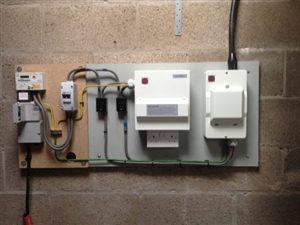
Chris Pearson:
It would seem that most people (including the DNOs and meter installers) don't bother.
Please don't confuse this with 521.10.202.
P-clips are good, but I also have some natty little devices which allow one to use a cable tie. Afraid I cannot remember where they came from, but it was an auto-electrical supplier.
Please excuse the somewhat fuzzy photograph - it was taken in poor light with a telephone.
Notice the double socket ..
Even if nothing is plugged in for normal use it is a good safe place to test earthing is present, L-N polarity is correct and a quick read of an upper limit for Zdb and a lower limit for PSSC for those situations that is required With the main switch off using a bit of cunning you can also do a whole site IR from there as well. Many countries recommend at least a single socket as part of the CU assembly for just this reason, along side an accessible earth terminal for wander lead R2 tests - saves having to do the equivalent of opening up the Henley blocks. (and means you can plug in your clip lamp, drill, radio whatever, without trailing leads.)
I'm in favour.
mapj1:
Notice the double socket ..
Even if nothing is plugged in for normal use it is a good safe place to test earthing is present, L-N polarity is correct and a quick read of an upper limit for Zdb and a lower limit for PSSC for those situations that is required With the main switch off using a bit of cunning you can also do a whole site IR from there as well. Many countries recommend at least a single socket as part of the CU assembly for just this reason, along side an accessible earth terminal for wander lead R2 tests - saves having to do the equivalent of opening up the Henley blocks. (and means you can plug in your clip lamp, drill, radio whatever, without trailing leads.)
I'm in favour.
We're about to take you to the IET registration website. Don't worry though, you'll be sent straight back to the community after completing the registration.
Continue to the IET registration site